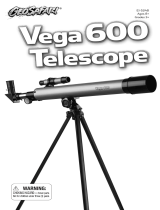
11
english
6) Insert the angle prism into the focusing tube (17). Secure by tightening the correspon-
ding fastening screws (see Fig. 5.) for model 90060 & 900114 see (Fig. 9).
7) Insert the eyepiece (13) into the angle prism (16). This also has to be adjusted with the
small fastening screw (see Fig. 6).
8) If you wish to use the prismatic eyepiece extension with the factor 1.5x or the 3x Barlow
lens, insert this between eyepiece (13) and the focusing tube (17) (see Fig. 7).
9) If your telescope is supplied with a moon filter you can screw the filter into the thread of
the eyepiece underneath before inserting the eyepiece into the focus tube.
USING THE SETTING CIRCLES TO LOCATE STARS
(90060 and 900114 only)
Since this equatorial telescope is designed to move in any direction, it can be set to track
the apparent movements of celestial bodies across the sky. This movement of celestial
bodies is in the direction opposite to that of the earth's rotation and is around the earth's axis
or celestial axis (Fig. 8). By simply aiming the telescope polar axis (21) at celestial North you
will automatically place the telescope in parallel with the earth's axis and thus be able to
locate stars in the sky based on information in star charts and star atlases. In simple
language you aim your telescope in the center of the celestial sphere that point in the sky
(like the hub of a wheel) and does not appear to move. The angle of declination is simply
900 minus the angle away from this hub. Celestial North is 90°. If you were at the North
Pole, you would point your telescope straight up to aim at celestial North.
To compensate for your position on the round earth, the polar axis (21) is set in one of two
simple ways. (see Fig. 8).
1) Set up the telescope at night. Loosen the declination axis clamp lever (24) (Fig. 9) and
turn the telescope around until the arrow points at 90° on the declination scale. Tighten
the declination clamp lever. The telescope is now in parallel with the polar axis.
2) Loosen the horizontal lever (22) (Fig. 9) and turn the telescope until the OPEN end
faces due North. This can be done by an approximate sighting on the Pole Star (Polaris)
or by the use of a compass to find magnetic north.
True North is then found by directing the telescope at the Pole Star, as magnetic North
is slightly away from the true North.
3) Look up the latitude of your area from a geographical atlas. Loosen the polar axis lever
(20) (Fig. 9) and set the latitude scale (23) (Fig. 9) to the correct latitude for your area.
Aim the sighting scope at the Pole Star. You will probably notice that Polaris (the Pole
Star) is not in the center of the crosshair finder scope. This is probably because your
telescope is not on even ground level.
Loosen the horizontal axis lever (22) again and turn the telescope so that it is directly
aimed at the Pole Star. Clamp both levers tight. Polaris is 1° off the North celestial pole.
Therefore, the sighting of stars will have to be slightly adjusted as you locate them in
the heavens.






